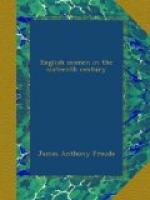Events had to take their course. Seamen were duly provided in other ways, and such as the time required. Privateering suited Elizabeth’s convenience, and suited her disposition. She liked daring and adventure. She liked men who would do her work without being paid for it, men whom she could disown when expedient; who would understand her, and would not resent it. She knew her turn was to come when Philip had leisure to deal with her, if she could not secure herself meanwhile. Time was wanted to restore the navy. The privateers were a resource in the interval. They might be called pirates while there was formal peace. The name did not signify. They were really the armed force of the country. After the war broke out in the Netherlands, they had commissions from the Prince of Orange. Such commissions would not save them if taken by Spain, but it enabled them to sell their prizes, and for the rest they trusted to their speed and their guns. When Elizabeth was at war with France about Havre, she took the most noted of them into the service of the Crown. Ned Horsey became Sir Edward and Governor of the Isle of Wight; Strangways, a Red Rover in his way, who had been the terror of the Spaniards, was killed before Rouen; Tremayne fell at Havre, mourned over by Elizabeth; and Champernowne, one of the most gallant of the whole of them, was killed afterwards at Coligny’s side at Moncontour.
But others took their places: the wild hawks as thick as seagulls flashing over the waves, fair wind or foul, laughing at pursuit, brave, reckless, devoted, the crews the strangest medley: English from the Devonshire and Cornish creeks, Huguenots from Rochelle; Irish kernes with long skenes, ‘desperate, unruly persons with no kind of mercy.’
The Holy Office meanwhile went on in cold, savage resolution: the Holy Office which had begun the business and was the cause of it.
A note in Cecil’s hand says that in the one year 1562 twenty-six English subjects had been burnt at the stake in different parts of Spain. Ten times as many were starving in Spanish dungeons, from which occasionally, by happy accident, a cry could be heard like this which follows. In 1561 an English merchant writes from the Canaries:
’I was taken by those of the Inquisition twenty months past, put into a little dark house two paces long, loaded with irons, without sight of sun or moon all that time. When I was arraigned I was charged that I should say our mass was as good as theirs; that I said I would rather give money to the poor than buy Bulls of Rome with it. I was charged with being a subject to the Queen’s grace, who, they said, was enemy to the Faith, Antichrist, with other opprobrious names; and I stood to the defence of the Queen’s Majesty, proving the infamies most untrue. Then I was put into Little Ease again, protesting very innocent blood to be demanded against the judge before Christ.’
The innocent blood of these poor victims had not to wait to be avenged at the Judgment Day. The account was presented shortly and promptly at the cannon’s mouth.




